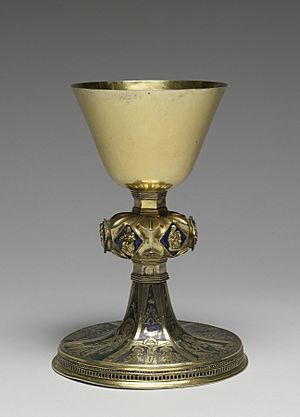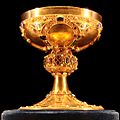Chalice facts for kids
A chalice is a special cup with a footed base. It's often used in religious ceremonies for drinking. Think of it as a fancy, important goblet.
Contents
Chalices in Religious Ceremonies
Christian Use of Chalices
In many Christian churches, like the Catholic Church, Eastern Orthodox Church, and Anglicanism, a chalice holds the sacramental wine during a service called the Eucharist. This service is also known as the Lord's Supper or Holy Communion.
Chalices are often made from valuable metals. They can be beautifully decorated with enamel (a type of glass coating) and jewels. In ancient Rome, a "calix" was a common drinking cup used at parties. Chalices have been used in Christian worship since the very early days of the church.
Because Jesus asked his followers to remember him by sharing bread and wine (as mentioned in the Bible in Luke 22:19 and 1 Corinthians 11:24-25), the Eucharist became a very important part of Christian worship. The cups used for this special act were often highly decorated and treated with great respect.
Early chalices sometimes had a large bowl and two handles. Over time, the bowls became smaller, and the bases became wider for better balance. Some church rules even say that the inside of the chalice cup must be made of gold.
Chalices in Western Christianity
In churches like Roman Catholicism, chalices often have a small knob or "node" on the stem. This makes it easier for the priest to lift the chalice during the service. Roman Catholic chalices usually have a tulip shape with narrow cups. New priests often receive a chalice as a gift from their families when they are first ordained (made a priest).
Chalices in Eastern Christianity
In Eastern churches (like the Eastern Orthodox and Eastern Catholic churches), chalices often have icons (religious images) carved or enameled on them, along with a cross. In these churches, everyone who takes Communion receives both the bread (called the Lamb or Host) and the wine. A piece of the bread is placed in the chalice, and then people receive Communion using a spoon. Because of this, Eastern chalices usually have larger, rounder cups.
In the Russian Orthodox Church, people often kiss the base of the chalice after receiving Holy Communion. In other traditions, they might kiss the cup itself. Even though Orthodox monks usually don't own personal things, a monk who is also a priest (called a hieromonk) is allowed to keep a chalice and other items needed for the Divine Liturgy (their main worship service).
Who Uses Chalices?
In the early and medieval church, when a deacon (a church helper) was ordained, they would be given a chalice during the service. This showed their role in the church. In Western churches, the deacon carries the chalice to the altar during the service. In Eastern churches, the priest carries the chalice, and the deacon carries a special plate called a paten. Only wine, water, and a piece of the Communion bread are allowed in the chalice. It should never be used for everyday purposes.
Blessing Chalices
The chalice is considered one of the most sacred items in Christian worship. It is often blessed before it is used. In the Roman Catholic Church, it used to be a tradition for a chalice to be consecrated (made holy) by being anointed with chrism (holy oil). Only a bishop or an abbot (for use in his own monastery) could do this.
Eastern Churches have different ways of blessing chalices. Some believe that the act of celebrating the service itself is enough to bless the chalice. Others have a special blessing ceremony. In some Eastern traditions, only a bishop can perform this blessing, while in others, a priest can do it.
In both Eastern and Western traditions, once a chalice has been blessed, it is usually only touched by ordained clergy (bishops, priests, or deacons). In the Russian Orthodox Church, a subdeacon (another church helper) is allowed to touch holy vessels, but only if they are wrapped in cloth.
Images for kids
-
Alabaster chalice found in Tutankhamun's tomb, from the 14th century BC.
-
Ceramic goblet from Navdatoli, Malwa, 1300 BCE.
-
Etruscan bucchero chalice, early 6th century BC.
-
A chalice from the Treasure of Gourdon, 6th century AD.
-
A reproduction of the Tassilo Chalice, from around 780 AD.
-
The Ardagh Chalice, 8th century.
-
A chalice from the treasure of the Cathedral of Reims, 12th century.
-
A Baroque chalice with a paten (small plate).
-
Wine Goblet, mid-19th century, from the Qajar dynasty.
-
Chalice of the Abbot Suger of Saint-Denis, found at the National Gallery of Art.
See also
 In Spanish: Cáliz (recipiente) para niños
In Spanish: Cáliz (recipiente) para niños























